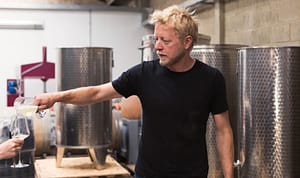As we enter into a new year we chose a bubbly fresh wine from a promising winery. The obvious choice would be champagne, of which the is a big amount to chose from, also in the natural end of the scale. But no, our choice is from England, itself a promising wine country.
I visited the Tillingham winery as we entered into the pandemic for the first time, and went straight into a quarantine, according to the rules that had been made while I was there. I will not go into details about the producer, as much is written already. Here is one of the write-ups.
The wines are produced as naturally as possible; which means no spraying in the vineyards, no unnecessary additives are added, and the wines are bottled with minimal sulphur.
This wine is made in and named after the italian method Col Fondo, in essence the same as the ancestral method. The grapes are mostly pinot noir, with chardonnay, pinot meunier and auxerrois. Hand-picked grapes ferment naturally in separate containers. Pinot noir and chardonnay are pressed directly as whole bunches and fermented in steel. Pinot meunier is also pressed as whole bunches of grapes and fermented in large Georgian qvevri. Auxerrois is mainly pressed as whole bunches of grapes and fermented in steel, as well as a small amount of yeast with a day’s skin contact before it is pressed into qvervi. After finishing the alcoholic fermentation, all the components in the steel tank are mixed with minimal amounts of sulphur added, and then the wine is bottled with 8 g/L added sugar. Thus the wine undergoes a second fermentation in the bottle.
Col 2019 (Tillingham Wines)
Light golden and somewhat cloudy. Aroma of lime, green fig and white flowers. Light and appealing, a moderate amount of tiny bubbles, with fresh acid, a bit creamy and with a quite long, dry finish.
Price: Medium
Food: Apéritif, natural shellfish, white fish, tapas…Perfect for celebrations.
Leave a Comment










